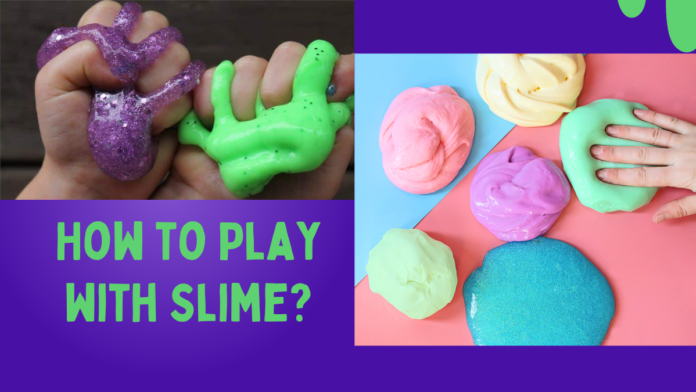Are you ready to dive into a world of slimy, squishy fun? Look no further because we’ve got the ultimate guide on how to play with slime! Whether you’re a seasoned slime enthusiast or just getting started, this blog post is packed with tips, tricks, and creative ideas that will take your slime experience to the next level.
Get ready for some gooey goodness as we explore different types of slime, share simple recipes, and reveal exciting ways to stretch, mold, and enjoy this captivating sensory toy.
What is Slime?
Slime is a non-Newtonian fluid that has properties of both liquids and solids. When left undisturbed, it acts like a solid. But when you apply pressure to it, it acts like a liquid. Slime is made from cross-linking polymers and usually contains Borax (sodium borate).
Benefits of Playing with Slime
There are many benefits of playing with slime, including:
- It’s a great sensory activity – Slime is a great way to stimulate the senses, including touch, sight, and smell. It can also be a calming activity for children who are feeling overwhelmed or anxious.
- It’s creative and stimulating – Playing with slime is a great way to encourage creativity and imagination. Children can use it to create all sorts of shapes and designs, or even make their own ‘recipes’.
- It’s great for fine motor skills – Manipulating slime requires the use of fine motor skills, which can help to improve hand-eye coordination and dexterity.
- It’s messy fun! – Letting children get messy can be really beneficial, and there’s no doubt that playing with slime is lots of fun too!
How to Make Slime?
Slime is always a hit with kids! It’s so satisfying to squish and stretch. Plus, it’s pretty easy to make at home. Here’s a simple recipe for slime that you can make with your kids.
Ingredients:
- 1/2 cup white glue
- 1/2 cup contact lens solution
- Food coloring (optional)
- Glitter (optional)
- 1/2 cup cornstarch
Instructions:
- Pour the glue into a bowl. Add the food coloring, glitter, and contact lens solution and stir until well combined.
- Pour the cornstarch into a separate bowl. Slowly add the cornstarch to the glue mixture, stirring as you go until the slime starts to form.
- Once the slime is the desired consistency, take it out of the bowl and start playing! Store in an airtight container when you’re done.
Different Types of Slime
Slime is a great way to have fun and relieve stress. There are many different types of slime that you can make at home or buy at the store.
- The most popular type of slime is clear slime. Clear slime is easy to make and can be tinted with food coloring to create any color you want. You can also add glitter or other decorations to clear slime to make it more fun.
- Another popular type of slime is foam slime. Foam slime is similar to clear slime, but it has a foamy texture that makes it even more fun to play with. You can add food coloring, glitter, and other decorations to foam slime to create your unique creation.
- If you want a challenge, try making Rainbow Slime. Rainbow Slime is made by layering different colors of clear slime on top of each other. When you mix the colors, they create a beautiful rainbow effect. Rainbow Slime is sure to be a hit with kids and adults alike!
- If you really want to go all out, try making Galaxy Slime. Galaxy Slime is made by adding shimmery paint and glitter to clear slime. It looks just like the galaxy and is so much fun to play with!
Creative ways to play with slime
Playing with slime can be a fun and sensory-rich experience. Here are some creative ways to enjoy slime:
- Slime Sculptures: Mold and shape the slime into 3D sculptures, animals, or abstract art. You can create a mini slime zoo or a slime masterpiece.
- Slime Marbling: Combine different colored slimes together to create a marbling effect. Swirl and twist the colors to make mesmerizing patterns.
- Slime Bubbles: Press a straw into the slime and blow gently to create bubbles within the slime. You can even make a slime volcano by adding baking soda and vinegar for a bubbly eruption.
- Slime Monsters: Add googly eyes, pipe cleaners, and craft foam to your slime to turn it into cute or spooky slime monsters.
- Slime Experiments: Use slime to explore science concepts. You can make magnetic slime, glow-in-the-dark slime, or even edible slime (using safe ingredients).
- Slime Fossils: Embed small toys or objects into the slime to create “fossils.” Kids can dig them out like archaeologists.
- Slime Art: Drip, drizzle, and pour slime onto paper or canvas to create unique abstract art. Once it dries, you’ll have a colorful, textured masterpiece.
- Slime Sensory Bins: Hide small toys, beads, or objects in a container of slime. Kids can dig in and discover treasures.
- Slime Races: Roll slime into balls and have a race by pushing them with your nose or using straws to blow them along a track.
- Slime Texture Exploration: Experiment with different slime recipes to create various textures – from fluffy and stretchy to crunchy and jelly-like.
- Slime Games: Incorporate slime into classic games like “Simon Says” or “Pictionary” by using slime-related challenges or drawings.
- Slime Science: Explore the properties of non-Newtonian fluids with slime. You can walk on it, punch it, or let it ooze through your fingers.
Remember to choose safe and non-toxic slime ingredients, especially if children are involved in the play. Always supervise young children when playing with slime, and make sure to clean up properly when you’re done. Enjoy the creative and tactile fun that slime can offer!
Safety Precautions
Most importantly, always wash your hands after playing with slime! If the slime is colored, there is a chance that it could stain your clothes or furniture, so be sure to play with it in an area that can get messy.
If you are using food coloring to color your slime, be aware that some colors may be more likely to stain than others.
If you notice the slime starting to dry out, add a few drops of water and knead it until it’s back to its original consistency.
Slime that has dried out cannot be saved, so be sure to keep it in an airtight container when you’re not playing with it.
Conclusion
Playing with slime is a fun and creative way to spend your time. Not only does it provide hours of entertainment, but playing with slime can also help you relax and destress.
With the right ingredients, a little patience, and some imagination – anyone can make their custom-made slime! So go ahead – grab your favorite colors and get creative. You never know what amazing creations you might come up with when you’re playing with slime!







